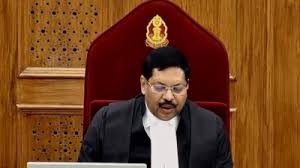Context:
The Chief Justice of India Sanjiv Khanna has recommended Justice Bhushan Ramkrishna Gavai as his successor. Once approved, Justice Gavai will become 52nd Chief Justice of India.
More on the news:
- He was elevated as a judge of the Supreme Court on May 24, 2019.
- He will take over as CJI after the retirement of the current CJI, and will remain in office till November 23, 2025.
- After Justice KG Balakrishnan, who was elevated to the country’s top judicial post in 2007, Justice BR Gavai will be the second Dalit to hold the Chief Justice position.
Constitutional Framework for appointment
- Article 124(2) of the Constitution mandates that the President appoints the CJI after consultation with judges of the Supreme Court.
- Article 217, which deals with the appointment of High Court judges, says the President should consult the CJI, Governor, and Chief Justice of the High Court concerned.
- The Memorandum of Procedure (MoP) formalizes the convention of appointing the seniormost judge as CJI.
- The outgoing CJI initiates the process by recommending their successor about a month before retirement.
- Since all SC judges have to retire at the age of 65, the length of a CJI’s tenure depends on how old they are at the time of their predecessor’s retirement.
Process of appointing:
- By convention, the seniormost judge of the SC (based on years of experience as a judge in the apex court) becomes the CJI.
- This process has now been put down in the ‘Memorandum of Procedure for the appointment of Supreme Court Judges’ (henceforth, referred to as the MoP).
- The MoP says that the “appointment to the office of the Chief Justice of India should be of the seniormost Judge of the Supreme Court considered fit to hold the office”.
- Even before the MoP was agreed upon in 1999, the seniormost judge of the Supreme Court after the CJI was by convention elevated to the top post.
- According to the MOP, the appointment process begins when “The Union Minister of Law, at the appropriate time, seek the recommendation of the outgoing Chief Justice of India for the appointment of the next Chief Justice of India”.
- By convention, the “appropriate time” for the process to begin is a month before the date of retirement of the incumbent CJI.
Government’s Role:
- The Law Minister forwards the recommendation to the Prime Minister, who advises the President.
- Though the Centre technically holds final authority, it has historically honoured the CJI’s recommendation.
To be appointed as a Supreme Court judge, a person must:
Be a citizen of India.
Have been:
- A judge of a High Court (or multiple High Courts) for at least 5 years, or
- An advocate of a High Court (or multiple High Courts) for at least 10 years, or
- A distinguished jurist (rarely used provision).
Powers & Functions of the CJI
- Master of the Roster: The CJI has exclusive power to assign cases to benches and schedule hearings in the Supreme Court.
- Head of the Collegium: The CJI leads the Supreme Court Collegium (CJI + 4 senior-most SC judges) for recommending appointments/transfers of SC & HC judges.
- Appointment of Ad-hoc Judges: Under Article 127, the CJI can appoint retired judges or High Court judges as ad-hoc Supreme Court judges.
- Change of Supreme Court Seat: With the President’s approval, the CJI can shift the Supreme Court’s sitting location from Delhi to another place (temporarily).
- Administrative Head: The CJI oversees the functioning of the Supreme Court and its registry.

